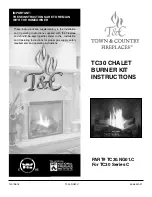
FLUE SPILLAGE MONITORING SYSTEM (continued)
The aeration hole of the pilot must be carefully cleaned out on each annual service to ensure continued func-
tion of the ODS.
The spillage monitoring system shall not be adjusted, modified, or put out of operation by the installer. Any
spare parts fitted MUST be of a type supplied for the purpose by the appliance manufacturer. If the fire is
not spilling, then further guidance should be sought, using the Troubleshooting section as a guide.
TESTING FOR SPILLAGE
Close all doors and windows to the room containing the appliance. Let the fire run on HIGH for five minutes.
Take a smoke match, light it, and using a smoke match tube, hold it at the top edge of the fire opening,
25mm down and 25mm in. Starting 50mm in from either side, run the smoke match across the opening. All
the smoke should be drawn away up the flue. Any smoke returning into the room indicates that
spillage is occurring. If the initial spillage test fails, run the fire for a further 10 minutes and repeat the test.
When the test has been completed satisfactorily, repeat with any extractor fans in the premises running on
the highest setting, and any communicating doors open. Finally, repeat with all doors open.
DO NOT allow the fire to be used until the test is satisfactorily passed.
BRIEFING THE CUSTOMER
All instructions must be handed to the user for safekeeping. Show the customer how to light and control the
fire.
After commissioning the appliance, the customer should be instructed on the safe use of the appliance and
the need for regular servicing. Frequency of service depends on usage, but MUST be carried out at least once
annually.
Advise that cleaning of the fire may be achieved when the fire is cold using a damp cloth and mild detergent
on most surfaces.
Scratched and other superficial damage to the matt black paintwork of the appliance can be covered with
matching heatproof spray. Use only the manufacturers’ recommended spray paint. Paint only when the fire
is OFF and cold. Always mask off the surrounding area to prevent contamination with overspray. Ventilate
the room during the use of the spray. DO NOT attempt to spray paint the coals or ceramics, or wash them
in water. Advise that the fire will emit a “newness” smell for a time after initial commissioning and that extra
ventilation may be needed during this time. Advise that the fire is fitted with a spillage safety device (O.D.S.).
If the fire shuts down, this system may be in operation. If spillage is suspected, SWITCH APPLIANCE OFF and
call in the installer to investigate any problems.
SERVICING
Isolate the fire from the gas supply. Ensure that the fire is fully cold before attempting service. A suggested
procedure for servicing is detailed below.
1. Lay out the dust sheet and tools.
2. Carefully remove the ceramic components.
3. Remove the cast front fret (Blenheim models), or remove the combined frame and firefront
(Aries and Aura models).
4. Remove the two screws that retain the data/control plate.
5. Disconnect the gas supply, and remove the two securing screws in the tray legs.
6. Remove the burner tray.
7. Remove firebox as described.
9
A.25mm down
from top of open-
ing
B. 25mm in from
front of opening.
C. Disregard
outer 50mm
either side of fire-
place opening
Match
Crimp
Tube
Cross section of smoke match tube
Make a smoke match tube from 10mm diameter
tube. Seal off one end and crimp the tube to pre-
vent the smoke match from sliding down inside.
C
C
B
A
Fireplace Opening
Smoke Match In
Tube
14.4
14.5
14.6
15.0
©
2009 Focal Point Fires plc.



































